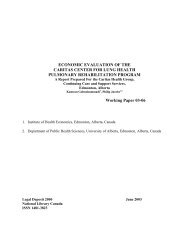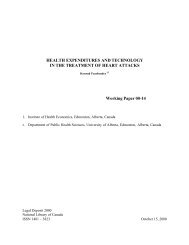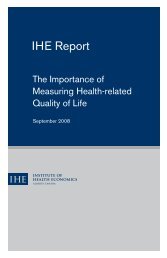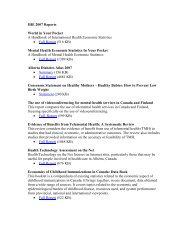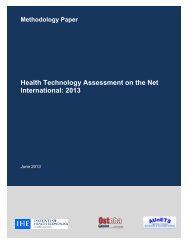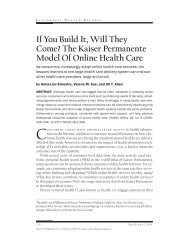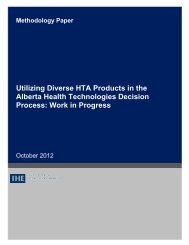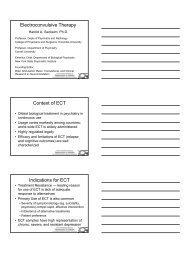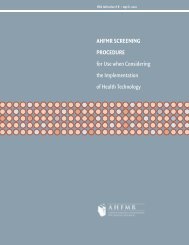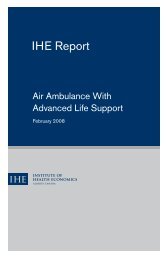Bariatric treatments for adult obesity - Institute of Health Economics
Bariatric treatments for adult obesity - Institute of Health Economics
Bariatric treatments for adult obesity - Institute of Health Economics
- No tags were found...
You also want an ePaper? Increase the reach of your titles
YUMPU automatically turns print PDFs into web optimized ePapers that Google loves.
APPENDIX T.E: EVIDENCE TABLE ON SAFETYTable T.E.1: Safety pr<strong>of</strong>ileSRs/HTAsAdverse eventsDietary therapy/physical exerciseGalani & Schneider, 2007 56Shaw et al., 2006 57Curioni & Lourenco,2005 58Behavioural therapyShaw et al,. 2005 15PharmacotherapyJohansson et al., 2009 59Padwal et al., 2004 20Li et al., 2005 60Not reportedNot reportedNo data were identified on adverse events.Not reportedThe median drop-out due to AEs (AE dropout ) was highest <strong>for</strong> rimonabant (15.0%; range 12.8 to 17.5%), intermediate <strong>for</strong> sibutramine (9.3%; range 0% to12.2%), lowest <strong>for</strong> orlistat (7.1%; range 0% to12.8%). Every single rimonabant study showed significantly more AE dropout with rimonabant than theplacebo group.The risk ratios <strong>for</strong> AE dropout were significantly elevated <strong>for</strong> rimonabant (RR 2.00; 95% CI: 1.66 to 2.41) and orlistat (RR 1.59; 95% CI: 1.21 to 2.08), butnot sibutramine (RR 0.98; 95% CI: 0.68 to 1.41).Compared to placebo, the risk difference was the largest <strong>for</strong> rimonabant (RD 7%; 95% CI: 5 to 9%; NNH 14, 95% CI: 11 to 19), followed by orlistat(RD 3%, 95% CI: 1 to 4%; NNH 39, 95% CI: 25 to 83), but no significant difference <strong>for</strong> sibutramine (RD 0.2%, 95% CI:3 to 4%; NNH 500). Themost common AEs leading to withdrawal were gastrointestinal <strong>for</strong> orlistat (40%) and psychiatric <strong>for</strong> rimonabant (47%).Orlistat GI side effectsPredominant in patients treated with orlistat; over80% <strong>of</strong> patients experienced at least one GI sideeffect, with an absolute frequency <strong>of</strong> 24% (95% CI:20 to 29%; 14 studies).Most commonly reported side effects: fatty/oilystool, fecal urgency, and oily spotting, eachoccurring in 15% to 30% <strong>of</strong> patients in moststudies.Approximately 5% <strong>of</strong> orlistat-treated patientsdiscontinued the therapy because <strong>of</strong> the side effects.Sibutramine BP and pulse rateSibutramine increased systolic BP by 1.7mmHg (95% CI: 0.1 to 3.3; 7 studies), diastolicBP by 2.4 mmHg (95% CI: 1.5 to 3.3; 7studies), and pulse rate by 4.5 beats/min (95%CI: 3.5 to 5.6; 7 studies) compared to placebo.Other AEs: insomnia, nausea, dry mouth, andconstipation were common, occurring in 7%to 20% <strong>of</strong> patients treated with sibutramine.Rimonabant psychiatric disordersDepression, anxiety, irritability, aggression,occurring in 6% <strong>of</strong> patients treated withrimonabant and was 3% more likely (95% CI:2 to 5%; 4 studies) compared to placebo.An increase in diarrhea (RR, 3.40), flatulence (RR: 3.10), and bloating, abdominal pain, and dyspepsia (RR: 1.48) was found in orlistat-treated patientscompared to placebo.<strong>Bariatric</strong> <strong>treatments</strong> <strong>for</strong> <strong>adult</strong> <strong>obesity</strong> 132



